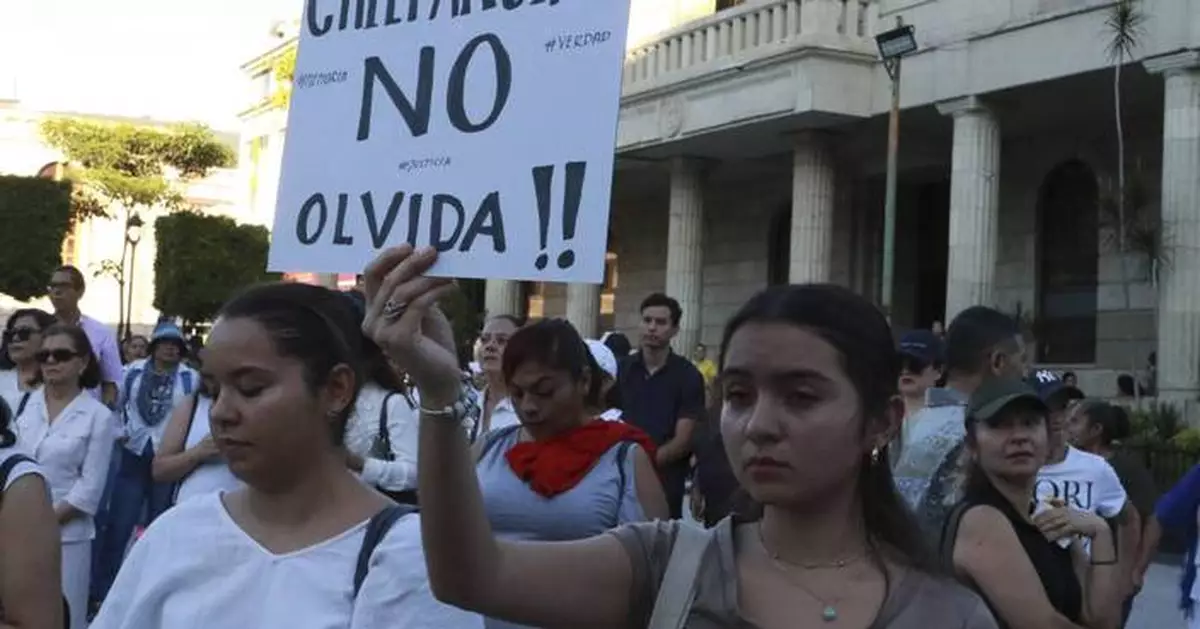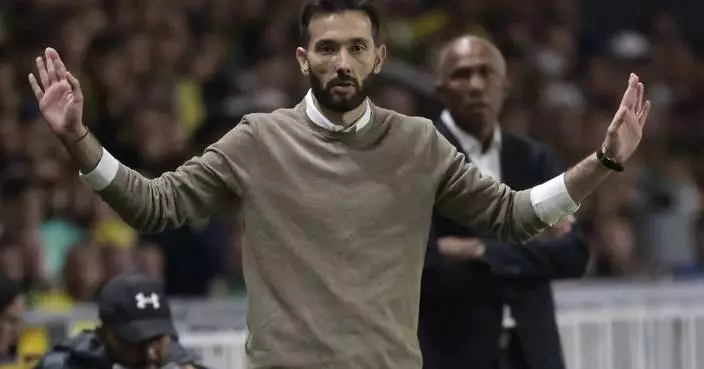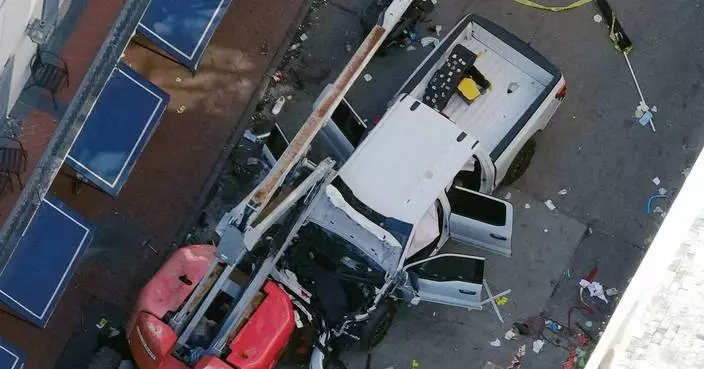MEXICO CITY (AP) — Among the many horrifying videos posted online amid Mexico’s drug cartel violence, few have been as profoundly shocking as that of a 14-year-old boy kidnapped in late October along with about a dozen family members in the country's south.
In the video, posted by his captors, the skinny, shoeless boy is seen sitting against a tree, his hands tied with rope and saying quietly that he works for a rival drug gang. The boy obviously spoke under duress, his schoolboy face tentative and cautious.
Authorities confirmed on Friday that 14-year-old Ángel Barrera Millán was one of four minors and seven adults whose dismembered bodies were found dumped in the back of a pickup truck on the side of a highway this week.
The deaths underscore the brazen power of the local drug cartels and the powerlessness of the government in the area around Chilpancingo — the capital of Guerrero state, where the resort of Acapulco is located — and the nearby township of Chilapa.
The boy's family was traveling on Oct. 21 to Chilapa to sell their stock of plastic household items — buckets, dishes and other containers — at an open-air market when they were abducted by The Ardillos, a local cartel that controls Chilapa and has been fighting the rival Tlacos for control of Chilpancingo.
“The state authorities have allowed these organized crime groups to gain very deeply rooted control of these areas,” an activist of the human rights group Tlachinollan said on condition of anonymity, for fear of reprisals. “This area is completely controlled by the Ardillos,” including some areas he said officials were loath to enter.
The video posted online suggests the family may have originally been kidnapped because one of their members had taken a cellphone photograph of the wrong person in town.
It is not clear what happened to the other two members of the group — 13 disappeared and 11 bodies were found, including three women and another boy who was 13.
The family's tragedy did not end with the 11 killed. On Oct. 27, four relatives went to look for the missing family, and were themselves abducted. They haven't been heard from since.
Until Nov. 6, when the bodies were found, state authorities had claimed they were searching far and wide in what had become a missing persons' case with 17 people, all relatives.
Prosecutors posted photos of police officers, soldiers, vehicles and drones fanning out over dirt roads and into the brush. The army called in helicopters, and a reward of about $50,000 was offered for information on the missing, but couldn't find them.
Apparently, the cartel likely killed them in Chilpancingo, the state capital with a population of 300,000. Their bodies were left on the main boulevard leading through the city, which also serves as the main north-south highway to Acapulco.
The family's death was not the first gruesome killing by the cartel.
In early October, the city’s mayor was killed and beheaded just a week after he took office. Alejandro Arcos took office on Oct. 1 in Chilpancingo. His body was found in a pickup truck a week later, his head placed on the vehicle’s roof.
In 2023, another gang hijacked a government armored car, blocked a major highway and took police hostage to win the release of arrested suspects.
The rights activist explained that the Ardillos control a large swath of the state's mountains, where they call obligatory community assemblies and force local residents to cooperate with the gang.
Mexican cartels frequently dump bodies of their hostages — or post grisly videos of torture, interrogation and decapitations of their victims — to intimidate their rivals and authorities.
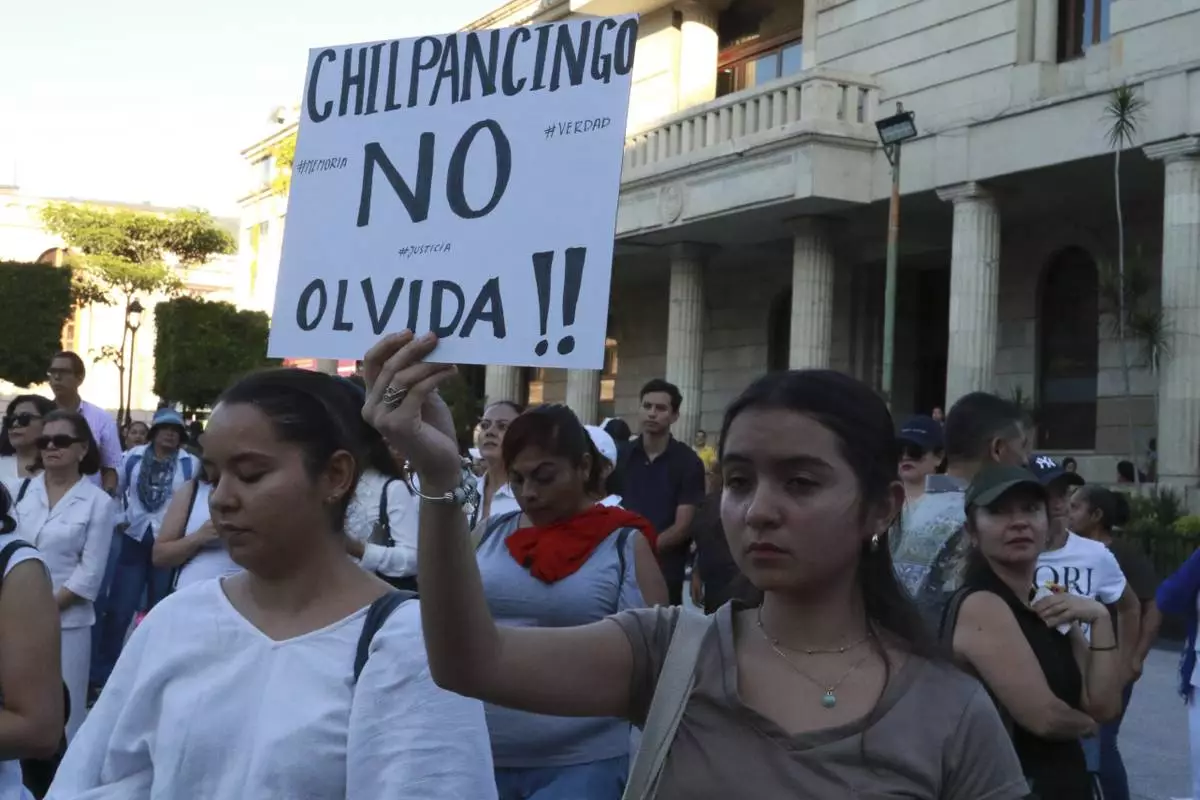
FILE - People demand justice for murdered Mayor Alejandro Arcos in Chilpancingo, Guerrero state, Mexico, Oct. 10, 2024. Arcos took office on Oct. 1 in Chilpancingo, and his beheaded body was found in a pickup truck a week later, his head placed on the vehicle's roof. (AP Photo/Alejandrino Gonzalez, File)
NEW ORLEANS (AP) — The FBI is investigating an early Wednesday attack in which a U.S. Army veteran drove a pickup truck into a crowd of New Year’s revelers in New Orleans, killing 15 people. The driver had posted videos on social media hours before the carnage saying he was inspired by the Islamic State group and expressing a desire to kill, President Joe Biden said.
The FBI identified the driver as 42-year-old Shamsud-Din Bahar Jabbar.
Officials have not yet released the names of the people killed in the attack, but their families and friends have started sharing their stories. About 30 people were injured.
Here is the latest:
ROME — A telegram of condolences, addressed to Archbishop Gregory Aymond, said Francis was saddened to learn of the attack in New Orleans and was spiritually close to the city.
Francis “prays for healing and consolation of the injured and bereaved,” said the telegram, which was signed by the Vatican secretary of state, Cardinal Pietro Parolin.
Separately, Italian President Sergio Mattarella also sent condolences to President Joe Biden, whom he will see during Biden’s visit to Rome next week, saying all of Italy was mourning the loss of life.
“At this time of sorrow for the American people, I would like to reaffirm the firm resolve of the Italian Republic to oppose in the strongest terms all forms of terrorism, on the basis of those values of civilization, democracy and respect for human life that have always been shared with the United States,” he said in a statement.
The College Football Playoff quarterfinal at the Sugar Bowl between Georgia and Notre Dame was postponed by a day because of the truck attack, which unfolded about a mile away.
The game, originally scheduled for 7:45 p.m. CST at the 70,000-seat Superdome on Wednesday, was pushed back to 3 p.m. Thursday. The winner advances to the Jan. 9 Orange Bowl against Penn State.
“Public safety is paramount,” Sugar Bowl CEO Jeff Hundley said at a media briefing alongside federal, state and local officials, including Louisiana Gov. Jeff Landry and New Orleans Mayor LaToya Cantrell. “All parties all agree that it’s in the best interest of everybody and public safety that we postpone the game.”
The decision to postpone the game meant numerous traveling fans with tickets would not be able to attend. Ticket prices online plummeted in some cases to less than $25 as fans with plans to depart on Thursday tried to unload them.
The Superdome was on lockdown for security sweeps on Wednesday morning. Both teams spent most of the day in their hotels, holding meetings in ballrooms.
▶ Read more about the decision to postpone the Sugar Bowl
Officials have not yet released the names of the 15 people killed in the New Orleans New Year’s Day truck attack, but their families and friends have started sharing their stories.
Here’s a look at some of what we know:
▶ Read more about the victims of the New Orleans truck attack
Authorities say the driver of a pickup truck sped through a crowd of pedestrians gathered in New Orleans’ bustling French Quarter district early on New Year’s Day, killing at least 15 people and injuring about 30 others. The suspect was killed in a shootout with police.
The FBI is investigating the attack as an act of terrorism and said it does not believe the driver acted alone.
Wednesday’s attack unfolded on Bourbon Street, known worldwide as one of the largest destinations for New Year’s Eve parties. Large crowds had also gathered in the city ahead of the College Football Playoff quarterfinal at the Sugar Bowl, which had been scheduled for later Wednesday at the nearby Superdome. The game was postponed until Thursday afternoon following the attack.
▶ Catch up on what we know about the New Orleans truck attack
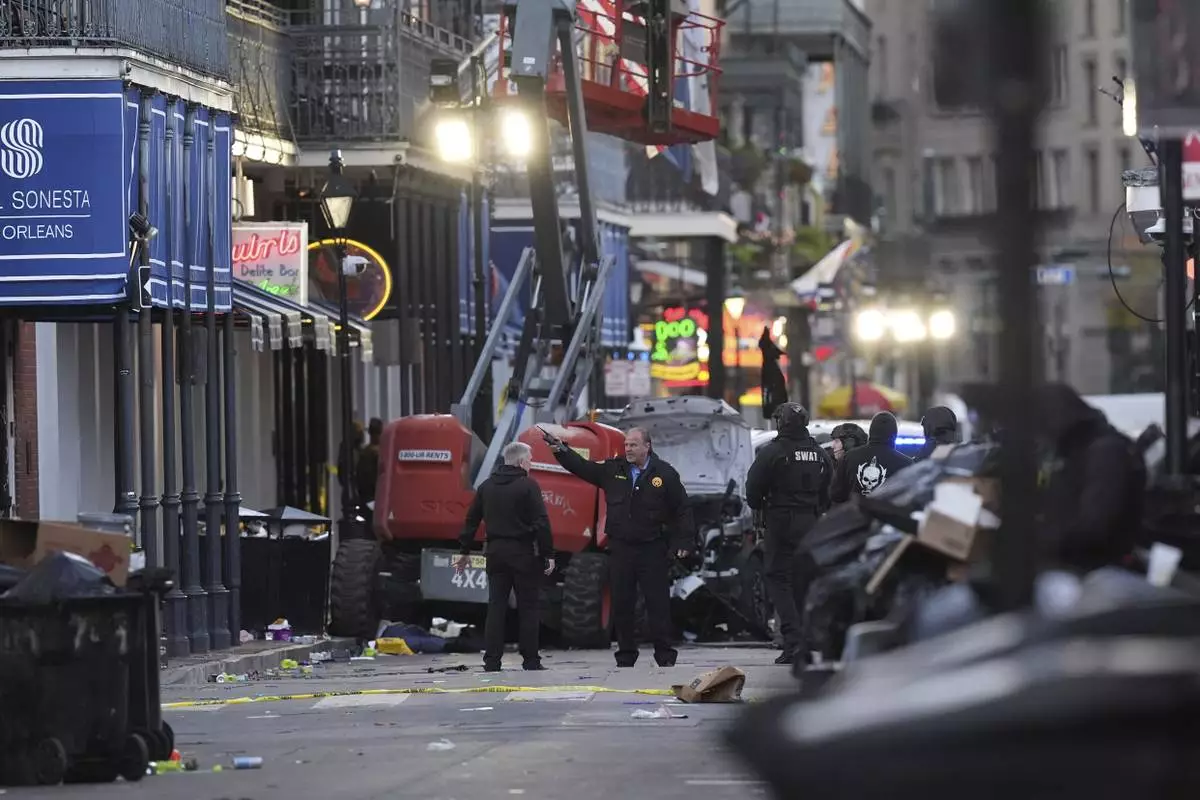
EDS NOTE: GRAPHIC CONTENT - Emergency personnel work the scene on Bourbon Street after a vehicle drove into a crowd on New Orleans' Canal and Bourbon Street, Wednesday Jan. 1, 2025. (AP Photo/Gerald Herbert)
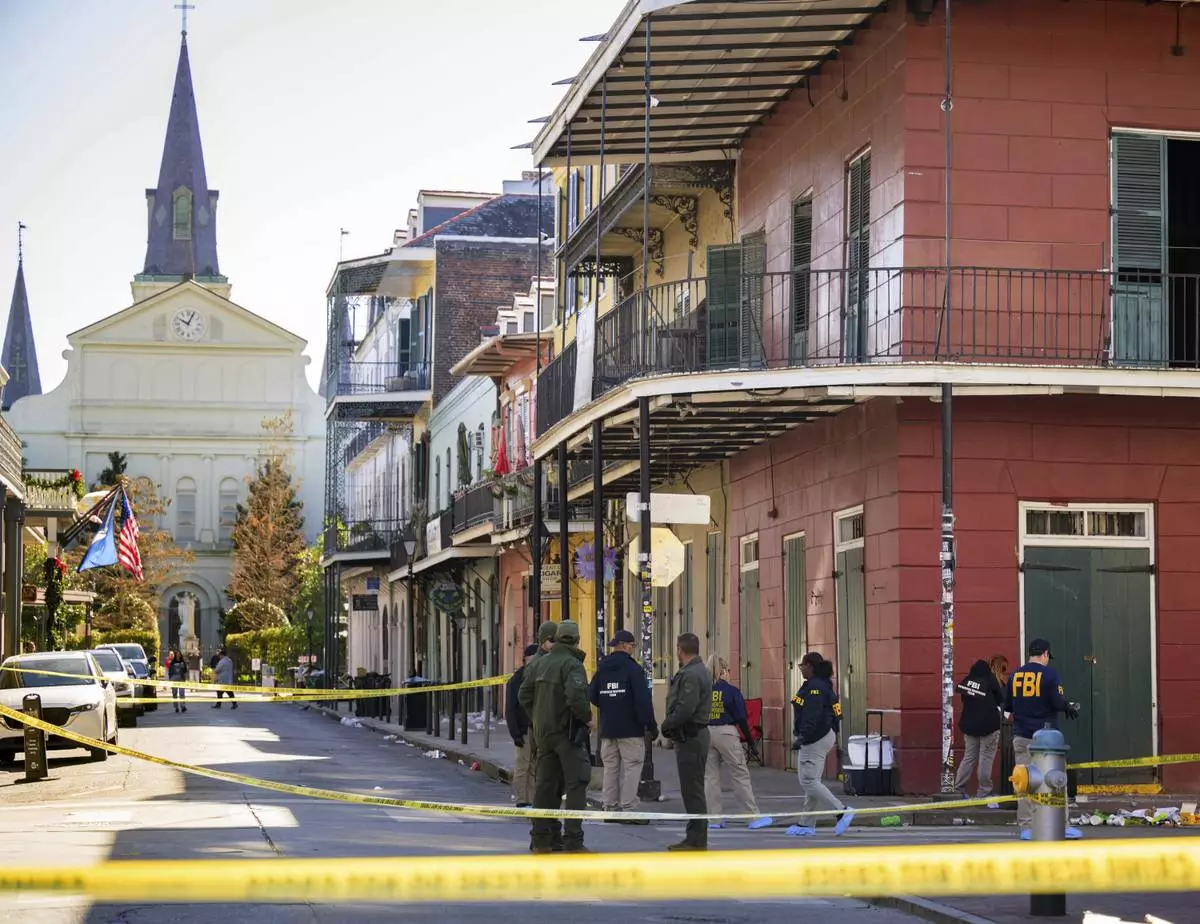
The FBI investigates the area on Orleans St and Bourbon Street by St. Louis Cathedral in the French Quarter where a suspicious package was detonated after a person drove a truck into a crowd earlier on Bourbon Street on Wednesday, Jan. 1, 2025. (AP Photo/Matthew Hinton)
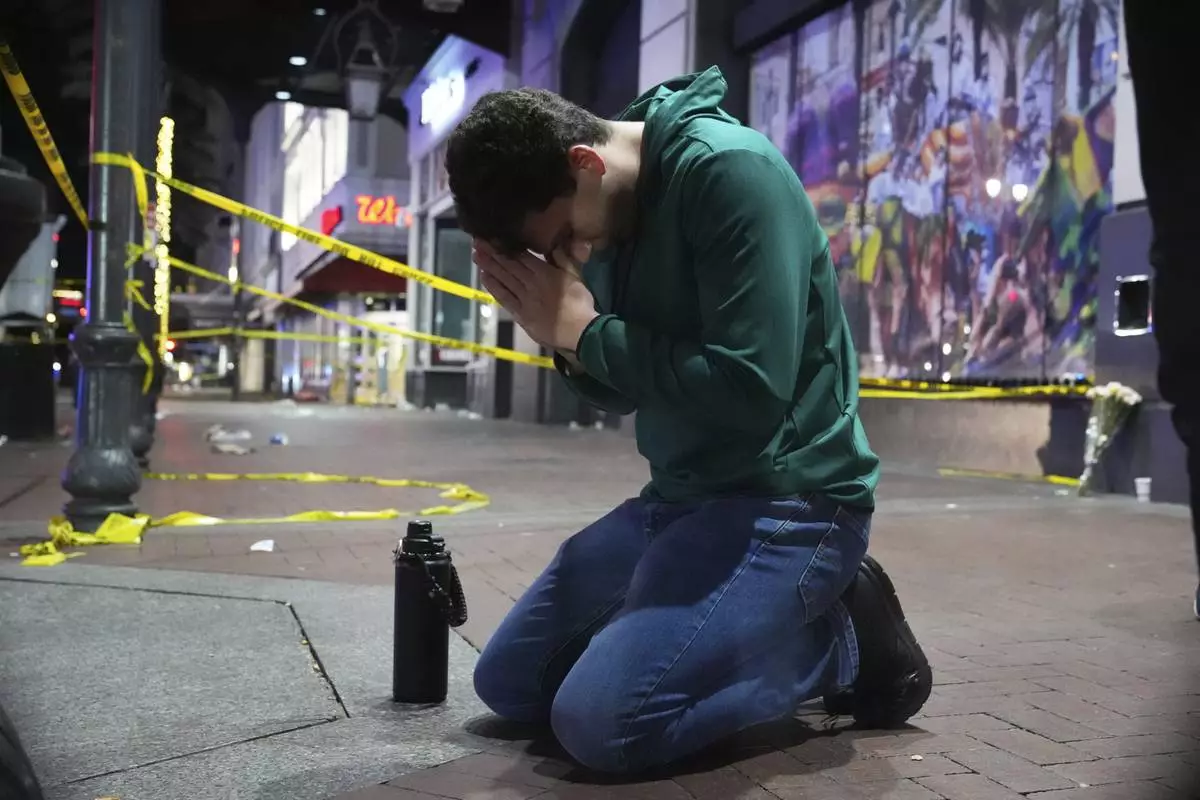
Matthias Hauswirth of New Orleans prays on the street near the scene where a vehicle drove into a crowd on New Orleans' Canal and Bourbon streets, Wednesday, Jan. 1, 2025. (AP Photo/George Walker IV)

A bouquet of flowers stands at the intersection of Bourbon Street and Canal Street during the investigation after a pickup truck rammed into a crowd of revelers early on New Year's Day, Wednesday, Jan. 1, 2025, in New Orleans. (AP Photo/Matthew Hinton)
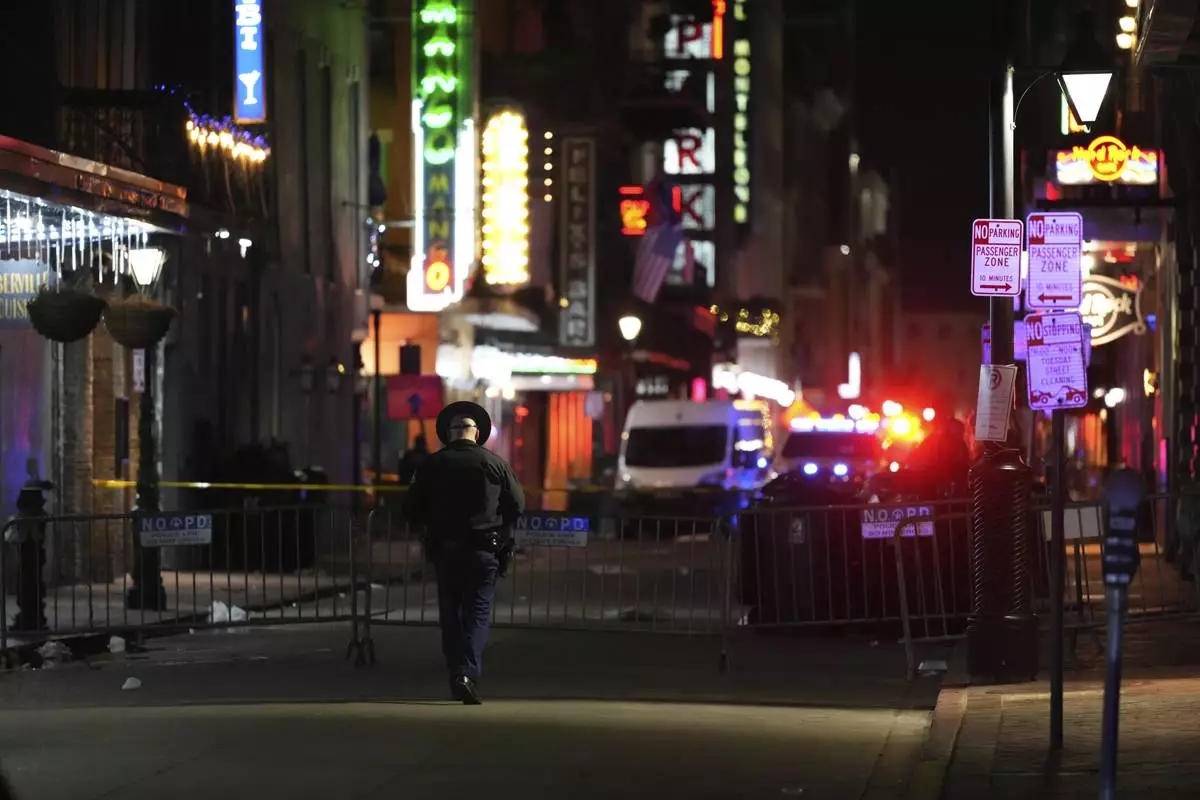
An officer walks along Conti Street after a vehicle drove into a crowd on New Orleans' Canal and Bourbon streets, Wednesday, Jan. 1, 2025. (AP Photo/George Walker IV)
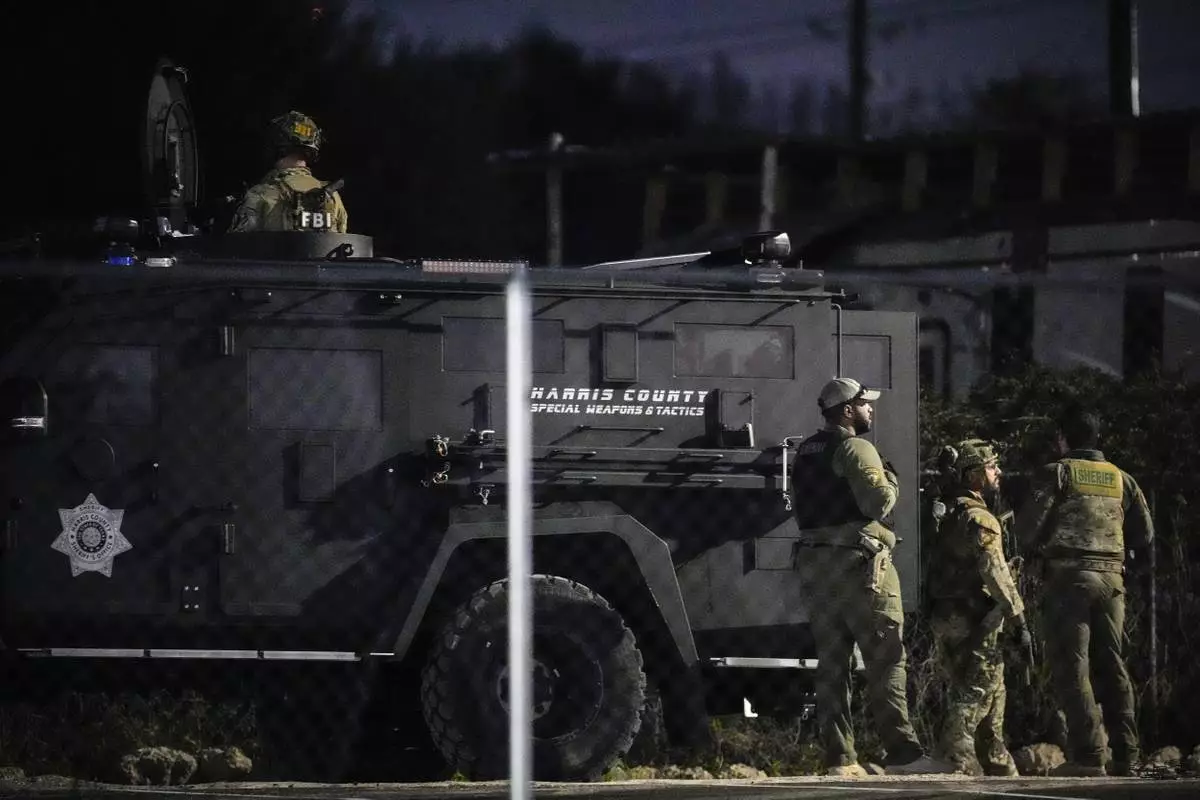
Law enforcement officers stand behind a SWAT vehicle near a location in Houston, Texas, Wednesday, Jan. 1, 2025, where police personnel investigate the place suspected to be associated with an attacker in a deadly rampage in New Orleans. (Brett Coomer/Houston Chronicle via AP)
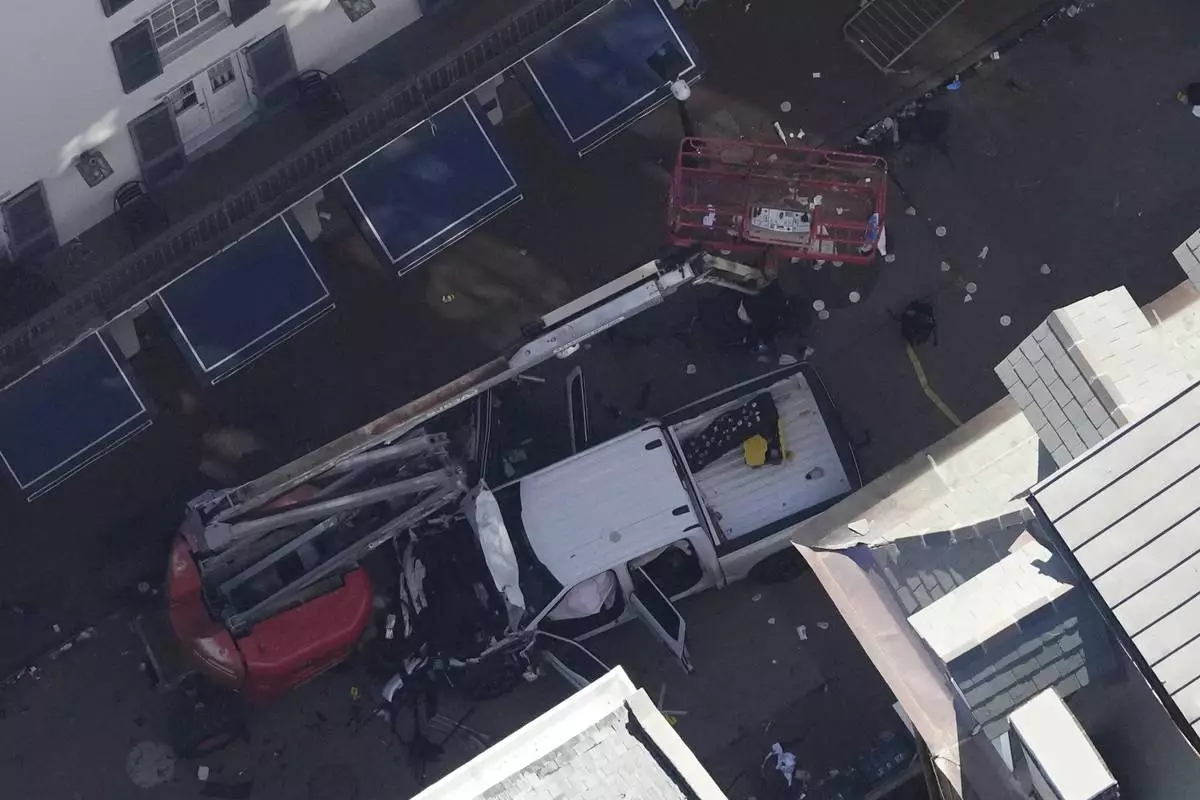
Investigators work the scene after a person drove a vehicle into a crowd earlier on Canal and Bourbon Street in New Orleans, Wednesday, Jan. 1, 2025. (AP Photo/Gerald Herbert)

Neighbors stand and watch outside the police lines surrounding a location in Houston, Texas, Wednesday, Jan. 1, 2025, where police personnel investigate the place suspected to be associated with an attacker in a deadly rampage in New Orleans. (Brett Coomer/Houston Chronicle via AP)
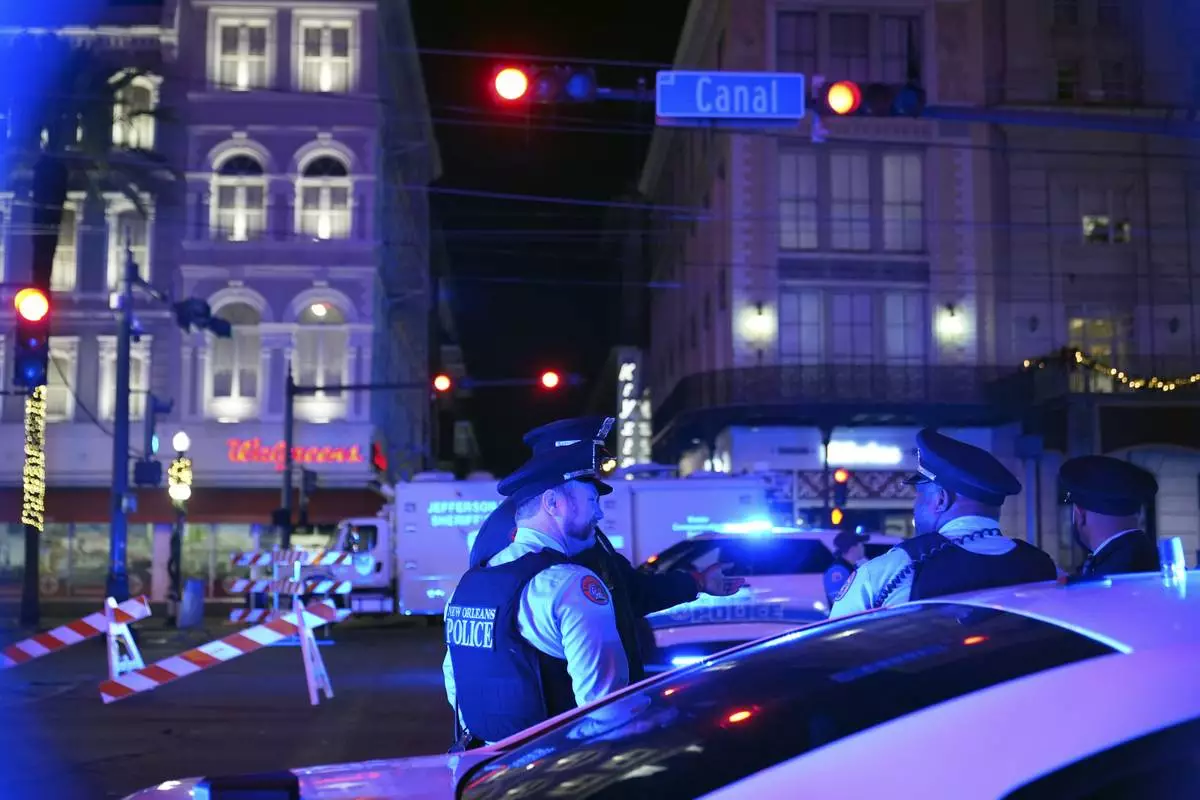
Police officers stand near the scene where a vehicle drove into a crowd on New Orleans' Canal and Bourbon streets, Wednesday, Jan. 1, 2025. (AP Photo/George Walker IV)
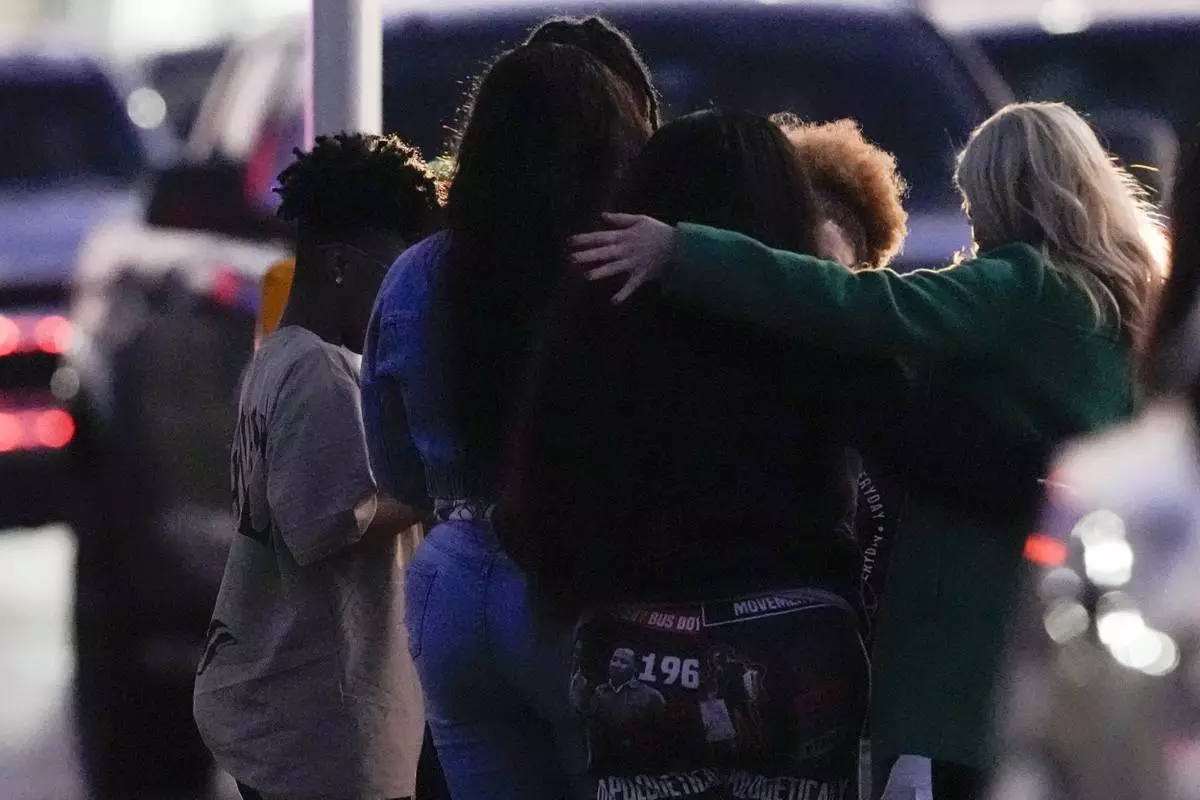
Neighbors embrace as they stand outside the police lines surrounding a location in Houston, Texas, Wednesday, Jan. 1, 2025, where police personnel investigate the place suspected to be associated with an attacker in a deadly rampage in New Orleans. (Brett Coomer/Houston Chronicle via AP)



